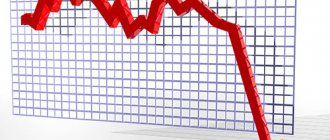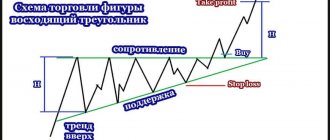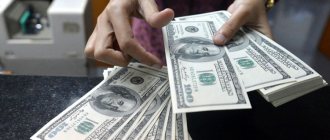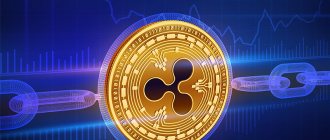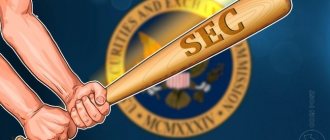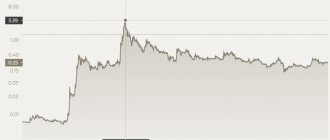Ripple is considered not only one of the leading crypto companies, but also a potential leader in the decentralized financial technology market. At the heart of the ecosystem is the XRP token, whose “official” status still raises questions among regulators and users. In early July, the main hearings on the SEC's claim regarding its similarity to the security are due to begin in the United States. Bloomchain was looking into what a lawsuit could mean for the platform.
At the end of 2022, the Securities and Exchange Commission (SEC) accused the California company Ripple Labs of unregistered sales of securities worth $1.3 billion. Ripple Chairman Chris Larsen and the company's CEO Brad Garlinghouse were also defendants in the lawsuit (.pdf). .
The SEC's lawsuit collapsed the price of XRP tokens - it fell by half in just a week. The regulator's claims led to several large cryptocurrency exchanges and platforms immediately stopping trading XRP - these included Binance, Coinbase, OKCoin, Galaxy Digital, Bitstamp, B2C2, eToro and Kraken.
The essence of the claim
According to the SEC, Ripple organized the distribution of tokens in two ways. The first is sales on open trading platforms according to a pre-agreed algorithm. The company’s documentation describes this method as “algorithmic sales.” They were most actively carried out on exchanges with the help of intermediaries and without direct control on the part of the issuer. According to the regulator, between 2013 and the end of 2022, XRP was sold in this way for a total of $763.37 million. However, Ripple stopped algorithmic sales back in 2019 due to their negative impact on the XRP rate.
In addition, the SEC complaint states that, starting in 2013, Ripple sold XRP tokens to institutional investors at a discount of 4% to 30% from the market price. The regulator notes that according to the terms of the agreements, the buyer did not have the right to resell these tokens for a period of 3 to 12 months. After this period expired, the holder was able to freely trade XRP on the retail market.
Those institutional investors included at least 26 companies, according to the SEC. One of them, Tetragon Financial Group, even tried to get the right to return most of the $200 million invested in Ripple after the SEC lawsuit. However, in this dispute the court sided with the defendant.
In the period from 2013 to 2022, which covers the SEC's statement of claim, the volume of such sales of Ripple amounted to $624.85 million. Thus, the total volume of funds earned and sales to institutions amounted to $1.39 billion - this is the amount stated in the SEC's claim.
The volume of “unregistered sales of securities” by Ripple in 2013 - 2022. Source: SEC filing
SEC "Crusade"
The peculiarity of the SEC's lawsuit is that back in 2015, another American regulator, the Financial Crimes Enforcement Agency (FinCEN), admitted that XRP is not a security, but a “virtual currency” (.pdf).
In FinCEN terminology, a “virtual currency” is a medium of exchange that operates within some ecosystems, but does not have all the attributes of a real currency; in particular, it does not have legal tender status in any jurisdiction. Virtual currency, according to the department, can be “convertible.” It then either has an equivalent value in real currency or serves as a substitute for it.
This definition of “virtual currency” differs from many others adopted by regulators in a number of countries. Among other things, it is beginning to be widely used to define CBDC (central bank digital currency) along with “digital currency.”
The Japanese regulator also considers the token a virtual asset. The project is supported by large companies, for example, SBI Holding. Ripple itself calls XRP “a digital asset designed to serve payments within the XRP Ledger blockchain environment.” The latter is an open blockchain platform for cross-border transfers.
However, this does not stop the SEC. Previously, her claims had already led to the failure of the launches of other digital platforms - TON, Libra and Kik.
The founder of the LFCS law firm, Yuri Brisov, compares such actions of the SEC with a crusade against the blockchain and notes that only defeat in court can stop it. “However, Ripple has a certain advantage over TON and Kik. The XPR token is much closer in its economic essence to bitcoin, which has already unconditionally recognized the right to be a cryptocurrency without any connection to the securities law,” he notes. It is around this position that Ripple’s defense strategy is built.
The company insists that XRP, and bitcoin with ETH, are not securities, but cryptocurrencies. Moreover, Ripple’s lawyers have already achieved their first small victory - they managed to obtain court permission to access internal SEC documents, which explain why the regulator refused to recognize bitcoin and ETH as securities.
The Commission's position on this issue was explained back in 2022 by the head of the SEC's Division of Corporate Finance, William Hinman. According to him, if the network is sufficiently decentralized, as is the case with bitcoin and Ethereum, then this is no longer an investment asset, and that is why there are no claims against them from the regulator. On the other hand, Ripple found defenders among former SEC leaders - ex-Chairman of the Commission Mary Jo White said that the regulator took an absolutely wrong position in the dispute with Ripple.
Despite the company’s position, it is worth saying that the decentralization of both the Ripple project and Ethereum itself is also often questioned. For example, according to the Blockchair portal, along with the zero block, 72 thousand ETH were sent to almost nine thousand addresses. Interestingly, during the entire period of the network’s existence (since July 2015), miners earned 60% less, 44 thousand ETH, according to coinmetrics. The sum of these two values gives the circulating supply. The Ethereum team is planning a transition from the PoW algorithm to PoS soon. This means that those network participants who store more tokens will receive greater control.
What happened
The US Securities and Exchange Commission brought charges against Ripple at the end of 2022. The regulator accused the company of selling unregistered securities under the guise of XRP tokens worth $1.3 billion.
XRP is Ripple's internal token that is used for cross-border payments. Amid the allegations, many crypto exchanges decided to suspend trading in XRP. This brought its price down to $0.17. On September 15, the altcoin was trading at $1.1.
In February, the parties were unable to resolve the dispute out of court. The SEC insisted that Ripple management was aware of the status of the XRP token even before its official launch. At the same time, Ripple CEO Brad Garlinghouse called the SEC’s accusations “unproven” and stated that the regulator’s actions are “a challenge to the entire US crypto industry.”
Is Ripple a scam?
In addition to the SEC, investors are also trying to sue Ripple. The latest class action lawsuit against the company was filed in January by Florida investor Tyler Toomey. He fully supports the regulator, believing that Ripple and Garlinghouse knew that the XRP token was a security, but ignored the mandatory registration procedure and misled customers with false statements. Toomey demands not only to fine the company and compensate investors for losses, but also to impose an injunction on its operations.
“It should be taken into account that a large number of courts against blockchain projects are so-called shakedowns, that is, processes of “shaking up money.” Nevertheless, they attract the attention of the regulator, who may form the opinion that the company is defrauding US citizens,” notes Brisov.
This position of the SEC is clearly visible in the text of the SEC’s statement of claim - the regulator clearly hints that the actions of Ripple’s executives amount to, at a minimum, deliberate misleading of investors for the purpose of personal enrichment. Garlinghouse's behavior is completely highlighted in a separate chapter in the text of the lawsuit. In five pages, the SEC details how Ripple's CEO promoted XRP as a reliable investment vehicle while actively selling it off.
Separate claims have also been made against Larsen. The Commission gives an example of a case where it approved limiting sales of XRP to one brand. In total, according to the regulator, the organization of schemes for the illegal sale of tokens brought Larsen and Garlinghouse about $600 million.
According to Yuri Brisov, despite constant attacks from investors and the regulator, there is no reason to suspect Ripple of fraud. “The company was simply unlucky from the very beginning. Maybe this is due to the complexity of the project for the general public. Or maybe for the reason that, unlike bitcoin, it has clear creators who continue to retain partial control over the project after the project has been launched,” he notes.
Director of the Alfacash cryptocurrency service Nikita Soshnikov notes that Ripple is not so much a cryptocurrency as a fintech project that has developed an ecosystem of payment solutions - from cryptocurrency (XRP) to services for the corporate sector (RippleNet with ODL, Line of Credit, RippleX, etc. ).
“The main argument of Ripple’s opponents is that XRP is not sufficiently integrated into the platform, and the utility cases for using the token are not obvious. Indeed, in a sense, it can be used as a means of obtaining liquidity, but in essence it is still an intermediary tool for making fast payments. Its mass use is hampered by the banking sector’s unpreparedness for the transition to digital currencies,” Soshnikov said in a conversation with Bloomchain.
Managing partner of the law firm Deaton and XRP holder John E. Deaton also points to this logic of the regulator’s accusations. He believes that the status of a “security” can be assigned to the Ripple token if the latter’s lack of applied tasks is proven in court. Deaton also filed a motion to intervene in the legal battle with the SEC on behalf of several thousand XRP holders.
Where is the lawsuit going?
Information about meetings between SEC employees and Ripple partners will not affect the course of the trial, Kazantsev believes. In his opinion, the outcome of this case will largely depend on the results of XRP tokens passing the Howey test.
The Howey Test is a test that determines whether certain transactions can be classified as an "investment contract." If the test is positive, such transactions are subject to the requirements of the Securities Act of 1933 and the Securities Exchange Act of 1934.
The most likely outcome of the case against Ripple is the achievement of some kind of agreement between the company and the regulator on the disclosure of some financial and corporate information, Nikita Soshnikov, director of the Alfacash cryptocurrency exchange service, is sure.
“Ripple’s victory in court is unlikely, since in my memory no crypto company has managed this. A settlement agreement, some other agreements within the framework of a judicial settlement - yes, but not a complete win of the case with the American regulator,” the expert explained.
Ripple ecosystem
A theoretical defeat for Ripple in court would have consequences for the XRP token, but is unlikely to lead to the death of the company itself. It has long been trying to shift the focus of development to expanding the ecosystem and line of various financial products: from payment infrastructure to credit and even logistics services.
“This project has long wanted to talk on an equal footing with global banks and payment services, offering them its services. However, it faced legal risks and an unwillingness to be publicly recognized as a significant financial infrastructure, and not just as another crypto company whose tokens are growing in price,” notes Viktor Pershikov.
Ripple ecosystem. Source: Ripple website
At the moment, the main risks of Ripple are associated specifically with XRP - the remaining instruments of the ecosystem are “removed” from the attack. However, the SEC statement contains information that casts a shadow, for example, on ODL (On-Demand Liquidity), a service of the RippleNet payment system that allows you to make cheap cross-border transfers using XRP with instant crediting of funds to the counterparty without prior deposit.
Thanks to the SEC's lawsuit, it turned out that by mid-2022, only a dozen and a half were using its services, the lawsuit says.
The regulator believes that the only incentive for these companies to use ODL are “rewards” from Ripple. “At least one of these companies has discovered that ODL is much more expensive to use—the business seeks compensation from Ripple,” the SEC said. According to the regulator, this company received $52 million from Ripple for continuing to operate ODL.
However, such a practice was known earlier - back in March 2020, The Block reported that Ripple paid $11.3 million to MoneyGram quarterly for the use of ODL. The exact list of projects that use the payment infrastructure is unknown. However, in late 2022 it was reported that these included funds transfer services Viamericas and FlashFX, freelance platform goLance and financial services provider Interbank Peru.
However, ODL is only one of Ripple’s products, and even if only 15 providers use it, this does not prove the inability of the developers of this company to create popular products.
At the moment, more than 300 companies from 55 countries, including American Express, are already connected to RippleNet, a system of decentralized b2b payment solutions for making cheap cross-border transfers. It is considered not only as a competitor, but also as a full-fledged replacement for the system for transferring interbank information and making payments (SWIFT). The company itself carefully states that both products can perfectly complement each other. At the same time, experts interviewed by Bloomchain believe that RippleNet has a very real chance of becoming an alternative to SWIFT.
Play big
Another direction in which Ripple is trying to develop is participation in projects to create national digital currencies (CBDC). Already at the end of 2022 ] was [/anchor] negotiating on this matter with several central banks, and later it became known that the XRP Ledger infrastructure could form the basis of the digital euro. At least, this is the option that Banque de France, one of the most influential financial institutions in the European Union, is leaning towards.
It is curious that the main reasons why the French central bank is inclined to partner with Ripple are the same factors for which it is most often criticized by both the regulator and users. This is a high level of network centralization and preliminary selection of nodes that are allowed to confirm transactions.
However, here the prospects for Ripple may be more vague, says Viktor Pershikov. “I see the role of the project in the creation and development of CBDC as extremely insignificant. It is unlikely that global banks will turn to a private blockchain solution for their needs; rather, they will develop their own decentralized networks and blockchain protocols. Perhaps this will happen, including with an eye on Ripple, but only from a technology point of view,” he notes. However, precedents for using external, even foreign, solutions to develop your own CBDC already exist.
What awaits Ripple and XRP after the trial?
Whether the company will have to introduce new utility tools into its ecosystem and whether it will eventually be able to “outgrow” the cryptocurrency market and become one of the largest players in the global financial services market will also depend on the outcome of the confrontation with the SEC.
So far, the Ripple token occupies one of the leading positions in the market: its capitalization by the end of May 2022 is approaching $50 billion - sixth position in the coinmarketcap rating. For comparison, the pharmaceutical company BioNTech, which produces the Pfizer COVID-19 vaccine, costs about the same.
The “too big to fall” status is one of the factors that increases the likelihood of a positive outcome of the trial for the defendant. “The SEC may be underestimating this risk. The industry protest [if Ripple loses] will be very significant. But the American law enforcement officer, nevertheless, in most cases is inclined to listen to society, since de jure and de facto he represents its interests,” believes Yuri Brisov.
Nikita Soshnikov agrees with this, noting that large financial organizations, including banks and payment systems that have become partners with Ripple in recent years, are also interested in resolving disputes with the SEC.
“However, we should not expect quick solutions. Practice shows that such court cases in the United States can take years to resolve. But still, the fact that Ripple has a wide partner network around the world should play into the company’s hands. There is no reason to believe that after the completion of the trial, XRP will become a thing of the past,” the expert concludes.
Last news
According to the latest document published by the SEC as part of the case against Ripple, representatives of SBI Holdings (Ripple's main partner) and other companies held meetings with regulator staff from 2022 to 2022, at which the XRP token was discussed. The document does not say what exactly the company representatives talked about with government officials.
The fact that SEC representatives held meetings with Ripple partners is not shocking, says Yuri Brisov, a member of the Commission on Legal Support of the Digital Economy of the Moscow Branch of the Russian Bar Association. According to him, American authorities regularly hold such meetings with business representatives.
“The very fact of meetings cannot indicate whether someone was aware of something. While there is no exact information about what exactly was discussed at the meetings, any conclusions about someone’s awareness will remain only guesses,” added Moscow Digital School expert Efim Kazantsev.
Even if at these meetings someone expressed an opinion on the need to register XRP tokens with the SEC, this is not the official position of the regulator, but the opinion of a private person, the lawyer explained.


